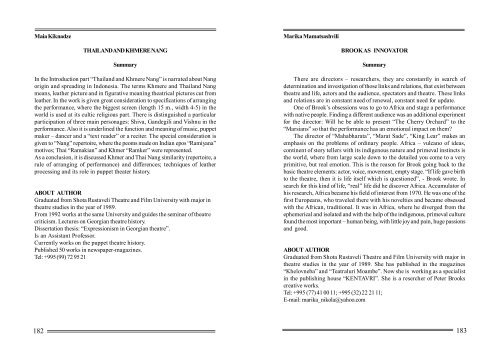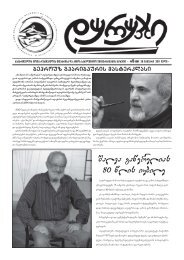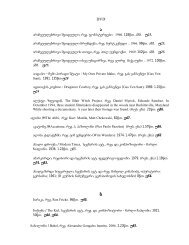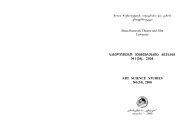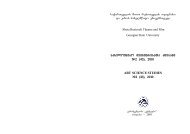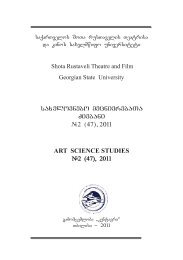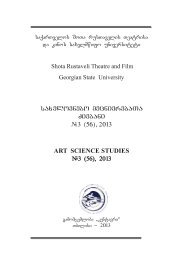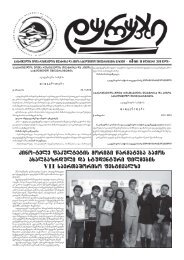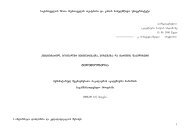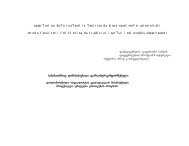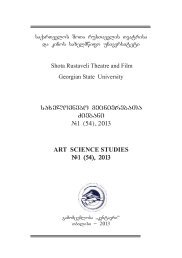saxelovnebo mecnierebaTa Ziebani #1 (38), 2009 ART SCIENCE ...
saxelovnebo mecnierebaTa Ziebani #1 (38), 2009 ART SCIENCE ...
saxelovnebo mecnierebaTa Ziebani #1 (38), 2009 ART SCIENCE ...
You also want an ePaper? Increase the reach of your titles
YUMPU automatically turns print PDFs into web optimized ePapers that Google loves.
Maia KiknadzeMarika MamatsashviliTHAILAND AND KHMERE NANGSummaryIn the Introduction part “Thailand and Khmere Nang” is narrated about Nangorigin and spreading in Indonesia. The terms Khmere and Thailand Nangmeans, leather picture and in figurative meaning theatrical pictures cut fromleather. In the work is given great consideration to specifications of arrangingthe performance, where the biggest screen (length 15 m., width 4-5) in theworld is used at its cultic religious part. There is distinguished a particularparticipation of three main personages: Shiva, Gandegili and Vishnu in theperformance. Also it is underlined the function and meaning of music, puppetmaker – dancer and a “text reader” or a reciter. The special consideration isgiven to “Nang” repertoire, where the peoms made on Indian epos “Ramiyana”motives; Thai “Ramakian” and Khmer “Ramker” were represented.As a conclusion, it is discussed Khmer and Thai Nang similarity (repertoire, arule of arranging of performance) and differences; techniques of leatherprocessing and its role in puppet theater history.ABOUT AUTHORGraduated from Shota Rustaveli Theatre and Film University with major intheatre studies in the year of 1989.From 1992 works at the same University and guides the seminar of theatrecriticism. Lectures on Georgian theatre history.Dissertation thesis: “Expressionism in Georgian theatre”.Is an Assistant Professor.Currently works on the puppet theatre history.Published 50 works in newspaper-magazines.Tel: +995 (99) 72 95 21BROOK AS INNOVATORSummaryThere are directors – researchers, they are constantly in search ofdetermination and investigation of those links and relations, that exist betweentheatre and life, actors and the audience, spectators and theatre. These linksand relations are in constant need of renewal, constant need for update.One of Brook’s obsessions was to go to Africa and stage a performancewith native people. Finding a different audience was an additional experimentfor the director: Will he be able to present “The Cherry Orchard” to the“Marsians” so that the performance has an emotional impact on them?The director of “Mahabharata”, “Marat Sade”, “King Lear” makes anemphasis on the problems of ordinary people. Africa – vulcano of ideas,continent of story tellers with its indigenous nature and primeval instincts isthe world, where from large scale down to the detailed you come to a veryprimitive, but real emotion. This is the reason for Brook going back to thebasic theatre elements: actor, voice, movement, empty stage. “If life gave birthto the theatre, then it is life itself which is questioned”, - Brook wrote. Insearch for this kind of life, “real” life did he discover Africa. Accumulator ofhis research, Africa became his field of interest from 1970. He was one of thefirst Europeans, who traveled there with his novelties and became obsessedwith the African, traditional. It was in Africa, where he diverged from theephemerical and isolated and with the help of the indigenous, primeval culturefound the most important – human being, with little joy and pain, huge passionsand good.ABOUT AUTHORGraduated from Shota Rustaveli Theatre and Film University with major intheatre studies in the year of 1989. She has published in the magazines“Khelovneba” and “Teatraluri Moambe”. Now she is working as a specialistin the publishing house “KENTAVRI”. She is a resercher of Peter Brookscreative works.Tel: +995 (77) 41 00 11; +995 (32) 22 21 11;E-mail: marika_nikola@yahoo.com182 183


